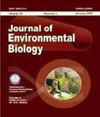Genetic analysis of zinc rich landraces for yield, quality and nutritional traits in rice (Oryza sativa L.)
IF 0.7
Q4 ENVIRONMENTAL SCIENCES
引用次数: 0
Abstract
Aim: To study genetic variability, correlation, path and Principal Component Analysis (PCA) in a set of 100 zinc rich rice landraces along with four checks. Methodology: The study was carried out at the Regional Agricultural Research Station (RARS), Maruteru, during Rabi season, 2020-2021 in an Augmented Randomized Block Design. Results: Grain yield per plant, grains per panicle, productive tillers m-2 and test weight showed moderate genotypic coefficient of variation (GCV) and phenotypic coefficient of variation (PCV) coupled with high heritability and genetic advance as per cent mean. These traits also had positive and significant association coupled with high positive direct effect on grain yield per plant. They also contributed maximum variance to the total variability indicating the effectiveness of direct phenotypic selection for these traits for improving the grain yield per plant. Further, cluster analysis grouped the zinc rich rice landraces along with checks into three clusters. Cluster II had the highest genotypes (42), while Cluster I had 32 genotypes and Cluster III consisted of 30 zinc rich landraces along with three check varieties. Interpretation: Grains per panicle, productive tillers and test weight were identified as effective selection criteria for the improvement of grain yield towards development of high yielding zinc-rich rice varieties to curtail micronutrient malnutrition in areas with rice as staple food. Key words: Cluster analysis, Landraces, Oryza sativa, Path analysis, PCA, Zinc水稻(Oryza sativa L.)富锌陆稻产量、品质和营养性状的遗传分析
目的:研究一组 100 个富含锌的水稻陆稻品种和四个对照品种的遗传变异性、相关性、路径和主成分分析(PCA)。研究方法:该研究于 2020-2021 年 Rabi 季节在马鲁特鲁地区农业研究站(RARS)进行,采用增量随机区组设计。研究结果每株谷物产量、每穗粒数、每平方米生产分蘖数和测试重量显示出中等的基因型变异系数(GCV)和表型变异系数(PCV),以及较高的遗传率和遗传进展(百分比平均值)。这些性状与单株谷物产量也有显著的正相关,并有较高的直接正效应。它们对总变异的贡献也最大,表明对这些性状的直接表型选择对提高单株谷物产量很有效。此外,聚类分析将富含锌的水稻陆稻品种和对照分为三个群组。聚类 II 的基因型最多(42 个),聚类 I 有 32 个基因型,聚类 III 由 30 个富锌陆稻品种和 3 个对照品种组成。解释在以水稻为主食的地区,每穗粒数、多产分蘖和测试重量被确定为提高谷物产量的有效选择标准,以培育高产富锌水稻品种,减少微量营养素营养不良。关键词聚类分析 陆稻 路径分析 PCA 锌
本文章由计算机程序翻译,如有差异,请以英文原文为准。
求助全文
约1分钟内获得全文
求助全文
来源期刊

Journal of environmental biology
ENVIRONMENTAL SCIENCES-
CiteScore
1.70
自引率
0.00%
发文量
92
审稿时长
3 months
期刊介绍:
Information not localized
 求助内容:
求助内容: 应助结果提醒方式:
应助结果提醒方式:


